A delicious loaf with complex flavour and texture, this whole wheat blend and sprouted grain sourdough is a great addition to your baking rotation. If you've been making sourdough for a while and would like to branch out, this sprouted loaf is an ideal place to start.
Sprouting is a natural extension of sourdough baking - especially if you're milling your own flour - and adding sprouted wheat makes for a more complex and highly textured loaf. It stands up well to just about any topping and toasts like a dream.
I you want some more sourdough bread recipes with whole grain flours, try our 100% whole wheat sourdough, rye sourdough bauernbrot, and whole wheat sourdough bagels.
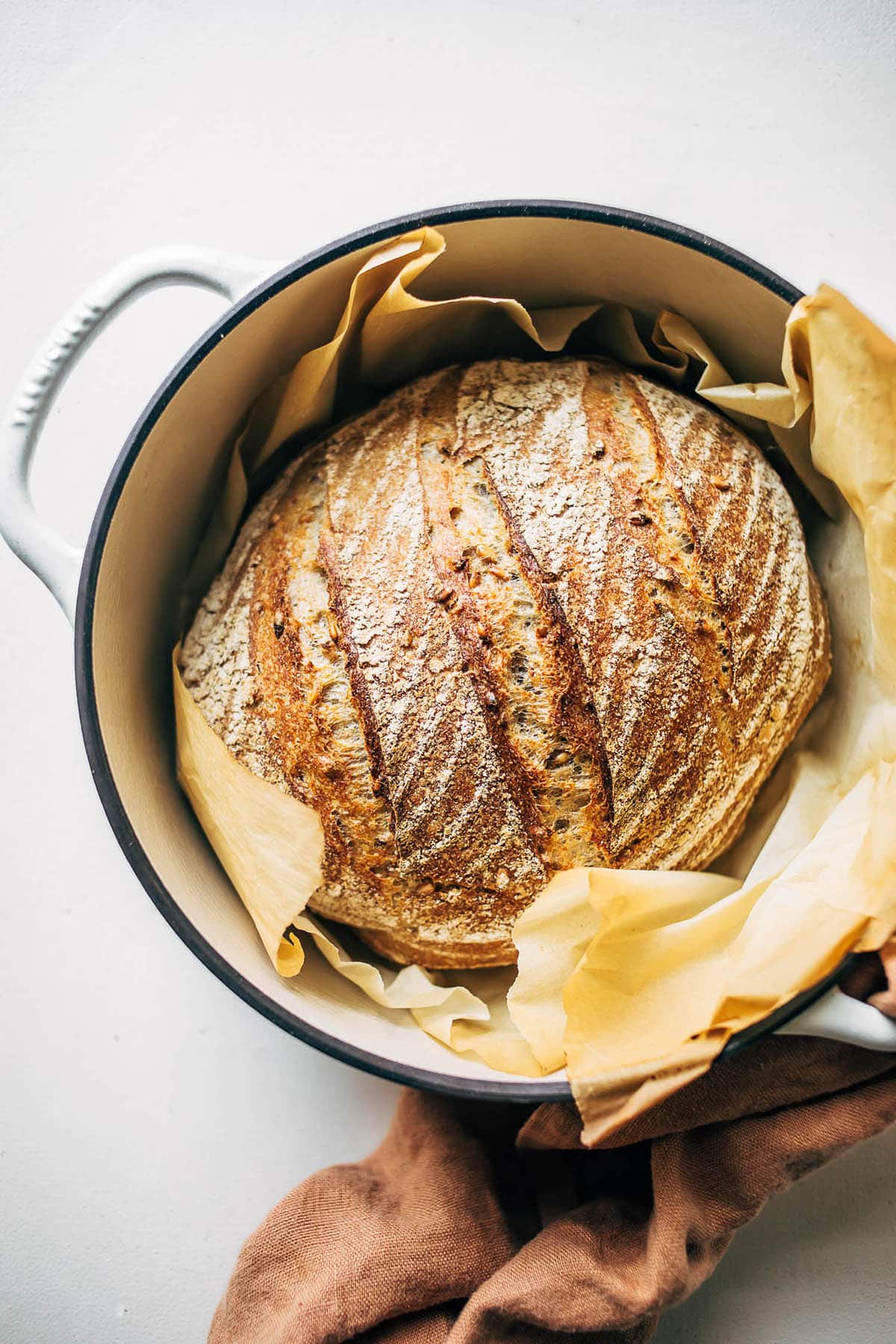
Jump to:
Ingredients
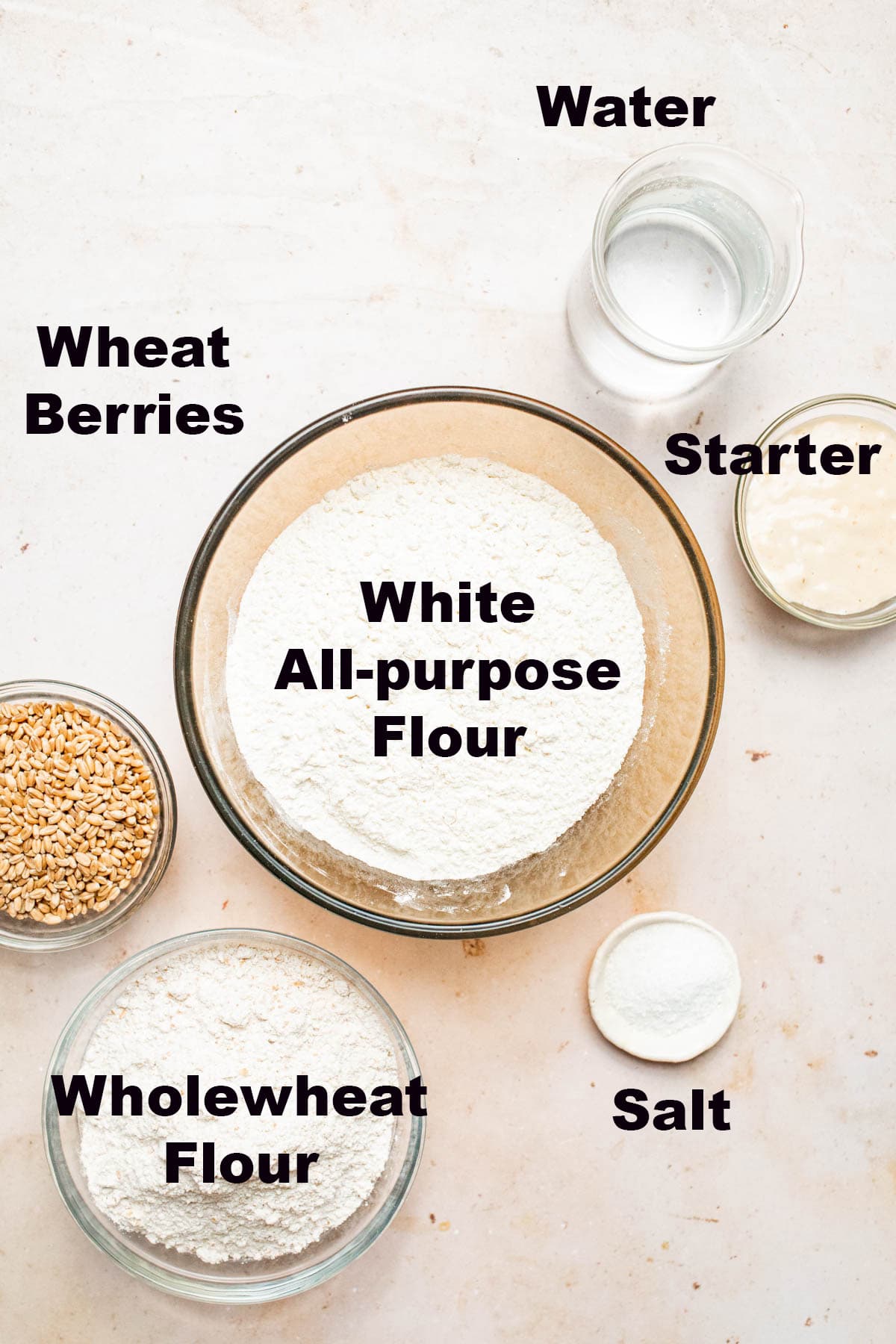
Ingredient Notes and Substitutions
- Flour: you can use bread flour in place of all-purpose and regular whole wheat instead of Red Fife. Flours much lower in gluten, like spelt, aren't an ideal sub for this recipe.
- Wheat berries: you can use any kind of sprouted grain if you don't have/can't find wheat berries. Think sprouted buckwheat, barley, rye, millet, or any other grain that will sprout. We particularly love the texture of wheat berries, though.
Method

Step 1: start by sprouting your wheat berries a couple days in advance.
Step 2: add the levain, water, and flours to a mixing bowl.
Step 3: mix to combine, using your hands if needed.
Step 4: mix in the salt and sprouted wheat, then do 6 rounds of stretches and folds.
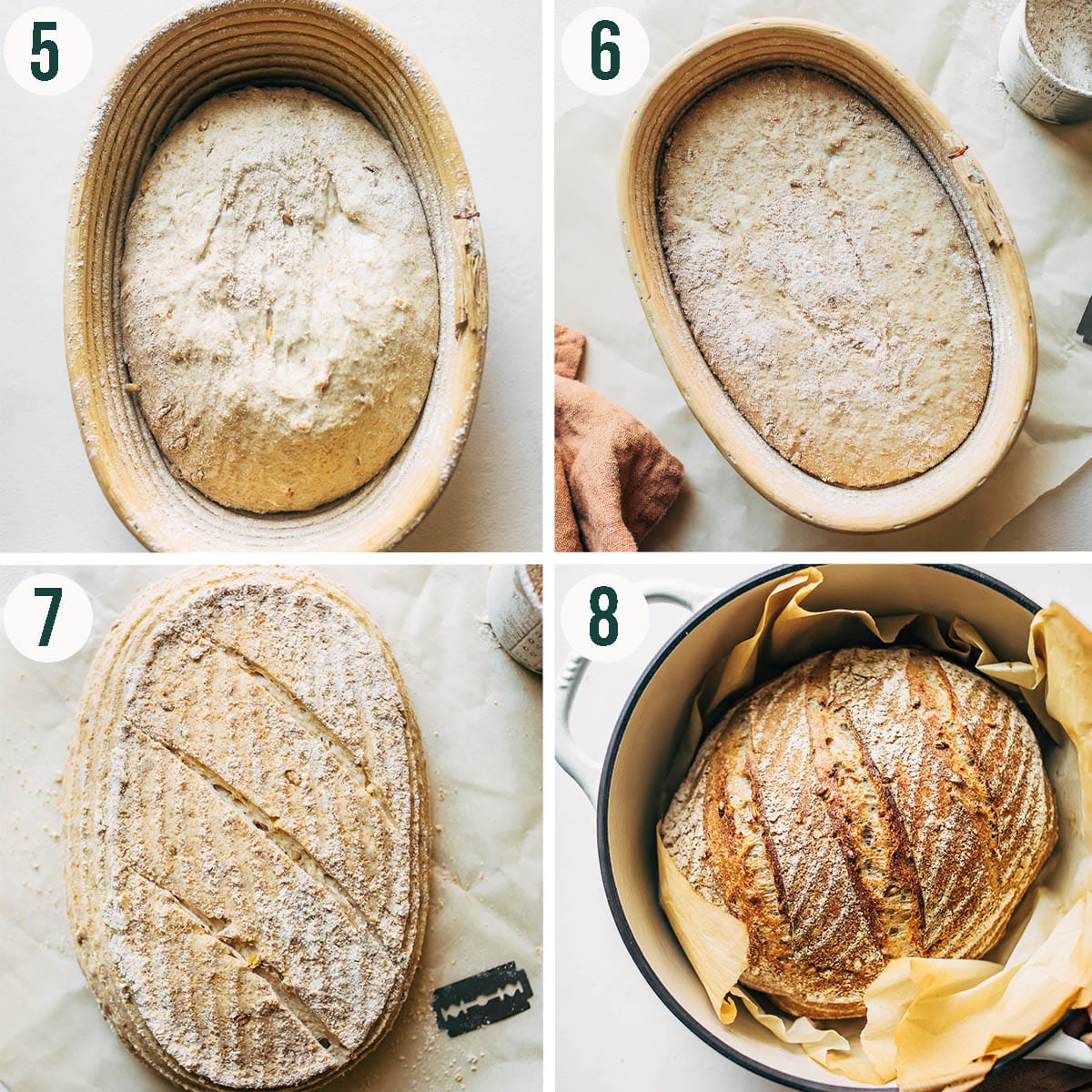
Step 5: shape the dough, then place it into a prepared banneton.
Step 6: refrigerate overnight. In the morning, preheat a dutch oven.
Step 7: when the oven is pre-heated, take the bread out and score it.
Step 8: bake until golden brown, about 45 minutes. Cool before slicing.
How to Make Your Own Sprouted Wheat
Two Days Before Making Bread
Take approximately ¼ cup of wheat berries (about 50 g) and soak them in enough water to fully submerge for 2 hours. Drain the wheat berries well, then transfer them to a mason jar (important for being able to watch their progress), and set them aside in a dark corner of your kitchen.
Rinse and drain the berries a few times throughout the day. By the end of day 1, you should notice small white tails coming from your grains.
The Day Before Making Bread
The tails of the wheat berries should be a little longer now (see photo below). The grain is now sprouted and will be ready for your bread. You will need to do this step a at least one day before you are ready to make the bread, but can do it several days in advance and store the fully sprouted wheat berries in the fridge until you are ready to bake.
Baker's Schedule
Day 1
Morning (24-36 hours)
Soak the wheat for sprouting: Place wheat berries in a jar and soak them in water for two hours. Drain and rinse them a few more times. Let them sit in a dark corner of your kitchen to sprout. See more details above.
Evening (overnight)
Make the Levain: Mix the starter, water, and flour together in a bowl. That's it. Cover the bowl with a plate and leave it on the counter to ferment overnight for approximately 8-12 hours.
Day 2
Afternoon
Autolyse: (30 minutes). Combine the fermented levain with the additional flours and water in a bowl. Let rest for 30 minutes.
Folding (3 hours): Add the sea salt and sprouted wheat berries to the dough and stretch and fold the dough every 30 minutes for the next 3 hours.
Rest, then shape (30 minutes): After the folds are complete, turn your loaf on to the counter and let rest before shaping. Prep your basket, banneton, or bowl for proofing.
Evening (Overnight)
Shape the loaf and place in a floured bowl or banneton (top-down, seam side up). Cover with a tea towel. Set in the fridge overnight.
Day 3
Morning (1 hour, 20 minutes). Preheat the dutch oven for 30 minutes. Bake the sourdough for 45-50 minutes. Remove the pot from the oven and carefully lift out the loaf using the edges of the parchment paper. Let it cool completely on a wire rack before slicing.
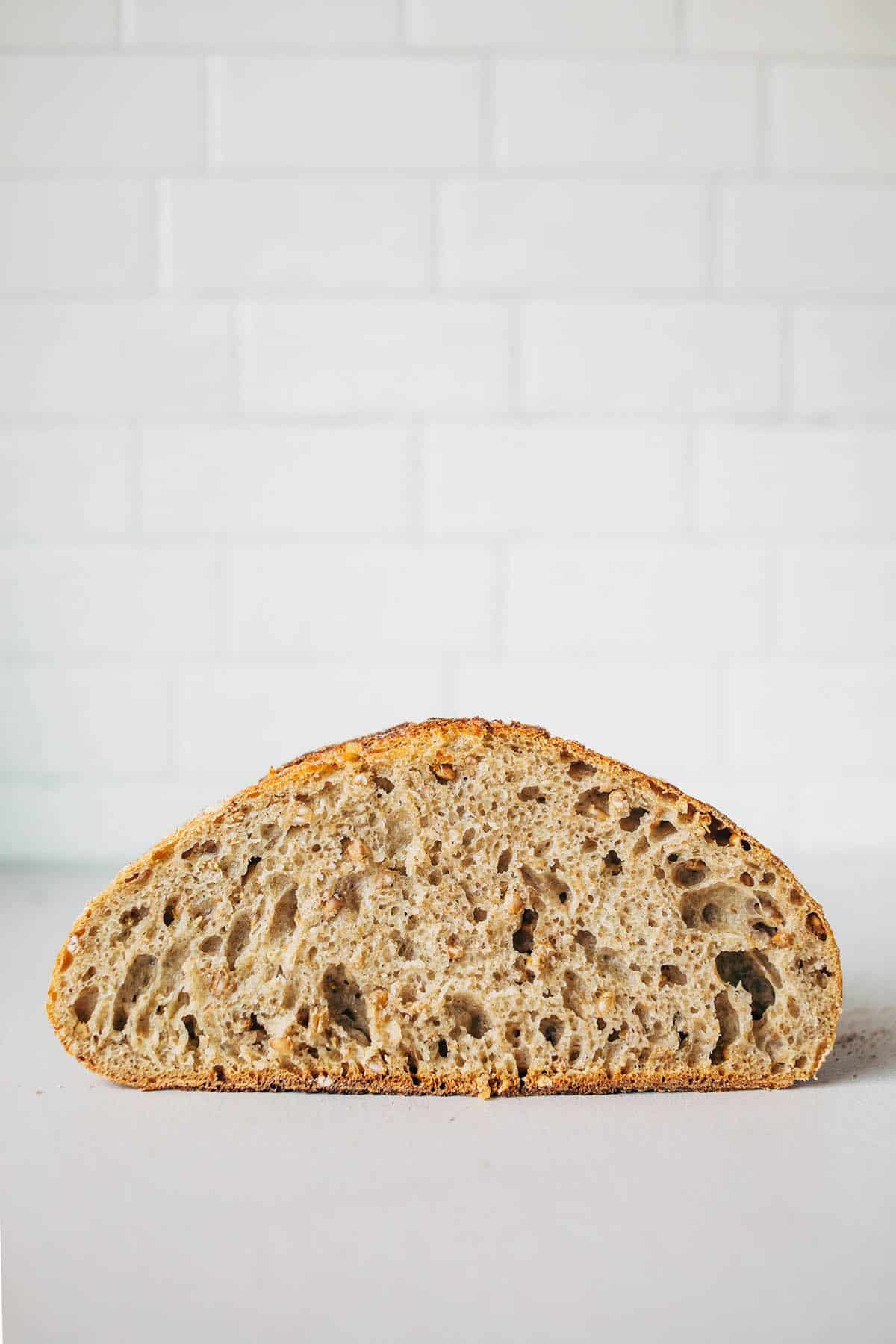
Red Fife Wheat
The whole wheat element in this loaf is whole grain Red Fife flour. Red fife is a heritage variety of wheat that was the Canadian baking standard of wheat from 1860 to 1900. Eventually, Red Fife was replaced with new strains of wheat that were more pest resistant.
Over the last 20 years, Red Fife has seen a resurgence in organic and artisanal bakeries and become more popular for home bakers. It has a similar nuttiness and can be compared to other more popular heritage grains like spelt, khorasan, and einkorn. You can often find it from small distributors such as Flourist.
About Sprouted Grains
Sprouted grains are whole grains that have been soaked and germinated (or allowed to sprout). This process allows the vital enzymes to be released which breaks down the starches and make the grain more digestible. The sprouted grains also add a nice chewy texture to the bread.
You can find wheat berries at most health food and bulk stores, or online. Sprouting them will take a couple of days, so you'll want to start sprouting at least one day before starting the levain. (See the schedule below for more detailed information.)
If you want to make the sprouted wheat berries in advance, they can be be made and refrigerated several days before using. Sprouted grains are ultra chewy and toothsome, so they add a nice texture to just about anything (they’re great in grain bowls).
Why We Use Levain (Leaven)
While you could use straight starter in your sourdough, and we often do, levain can be easier for a number of reasons. Yes, it adds an extra overnight rise to the process, but it also means that you can use your starter straight from the fridge.
Unless you're feeding your starter daily and it's almost always ready to use, making a levain is often a more practical solution because your main starter can stay inactive and stored away. It also means that you can control the type of flour going into your loaf more easily.
You can see in our sourdough sandwich bread, for example, that it almost looks like a whole grain blend. That's because we used a 100% rye starter, so it looks like there's some whole wheat flour in the mix. A mostly all-purpose levain, with just a little bit of starter, would solve that.
FAQ
Why do I have to let my sourdough cool down before slicing?
If you cut your sourdough bread - especially whole grain loaves - before it's cooled, you usually end up with gummy bread. It needs time to rest, just like an apple pie.
What is sprouted sourdough bread?
Sprouted sourdough might be made with sprouted wheat berries mixed into the dough, or it might be made with flour that's been made from dried sprouted wheat.
What is a sprouted grain?
Sprouted grains are whole grains that have been soaked and then allowed to sprout - start to grow - before being used or dried. Just like bean sprouts, but with grain, and it has to be whole grains.
More Great Sourdough Recipes
If you make this Sprouted Sourdough Bread recipe or any other sourdough bread recipes on the Baked Collective, please take a moment to rate the recipe and leave a comment below. It’s such a help to others who want to try the recipe. For more baking, follow along on Instagram, TikTok, and YouTube.
Sprouted Grain Sourdough Bread
Equipment
- Digital kitchen scale
- 2 Mixing bowls
- Tea towel
- Banneton
- Dutch oven
- sharp knife or bread lame
- Wire rack
Ingredients
For the Levain
- 25 grams sourdough starter see notes
- 50 grams water room temperature
- 50 grams all-purpose flour
For the Bread
- 105 grams levain made the night before- see instructions
- 320 grams water room temperature
- 260 grams white all-purpose flour
- 175 grams whole wheat flour*
- 10 grams sea salt
- 100 grams sprouted wheat berries see instructions in post
Instructions
TWO NIGHTS BEFORE BAKING (see notes)
Make the Levain:
- In a medium mixing bowl, mix together starter, water, and flour.25 grams sourdough starter, 50 grams water, 50 grams all-purpose flour
- Cover bowl with a plate and leave it on the counter to ferment overnight, approximately 8-12 hours.
One Day Before Baking
- Once your levain is bubbly and active, remove 3.7 oz. (105 grams). Transfer to a large mixing bowl and mix with water until well-distributed. Add the white and whole wheat flours and, using a dough whisk and/or your hands, mix to form a shaggy dough.105 grams levain, 320 grams water, 260 grams white all-purpose flour, 175 grams whole wheat flour*
- Cover with a tea towel and rest at room temperature for 30 minutes.
- Next, add salt and sprouted wheat berries. Using your hands to squish everything together, mix to combine.10 grams sea salt, 100 grams sprouted wheat berries
Do the first fold:
- To do this, get your hands damp and reach under the dough on the opposite side of the bowl from you. Pull the dough up and over towards you.
- Repeat this so the side closest to you now folds to the side farthest from you. Lastly, repeat this so that the side on your left folds towards your right and your right folds towards your left. Think of it as wrapping a package. Then, scoop your hands under the ball of dough and flip it over completely. This completes one “fold”.
- Complete 6 more folds: Do one fold every 30 minutes for 3 hours total.
Shaping the dough:
- Tip the dough out of the bowl onto a lightly floured surface and rest 20 minutes. Don't skip this rest step! Meanwhile, prepare your banneton by dusting it with flour. Alternatively, layer a clean tea towel in a medium mixing bowl and dust liberally with flour (50-50 wheat and rice flour is a great dusting combo).
- To shape, flour a clean surface with just a touch of flour. Too much flour will prevent the dough from sticking to the surface and getting taut.
- Gently fold the bread up like a burrito, then flip it over so that it’s seam side down, and use your hands to cup and roll the dough. You want to make as much surface tension as possible without tearing the outside of the loaf.
- Once shaped, turn the loaf into the banneton (top-down). Gently flour the top of the loaf (which is actually the bottom) before covering with a towel.
- Transfer the shaped loaf into the fridge to rest overnight.
Day of Baking
- Place a dutch oven in the oven and preheat to 260°C (500°F) or as hot as your oven can go, but no higher than 500°F. After the oven has come to temperature, let the dutch oven continue to preheat for another 30 minutes.
- Once preheated, take bread out of the fridge. Gently invert the dough onto a piece of parchment paper (seam side down) that is large enough to lift your bread into and out of the dutch oven.
- Score the bread with a sharp knife or bread lame.
- Using oven mitts, carefully remove the hot dutch oven placing it on the stovetop. Remove the lid, then quickly and carefully lift the dough into the pot using the edges of the parchment paper as handles. Using oven mitts, carefully place the lid back on the dutch oven and put the vessel back into the oven.
- Reduce oven temperature to 230°C (450°F) and bake for 25 minutes. Carefully remove the lid (be careful of steam) and bake for another 20-25 minutes with the lid off, or until the bread is golden to dark brown (depending on preference) and crusty.
- Using the parchment paper as handles, transfer the bread from the dutch oven to a wire rack. Cool completely on a wire rack before cutting into it, at least 4 hours.


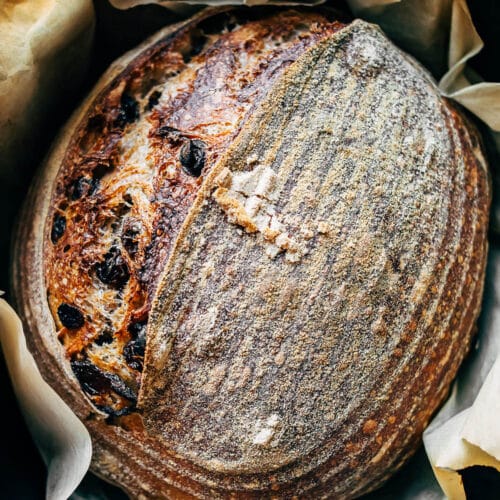
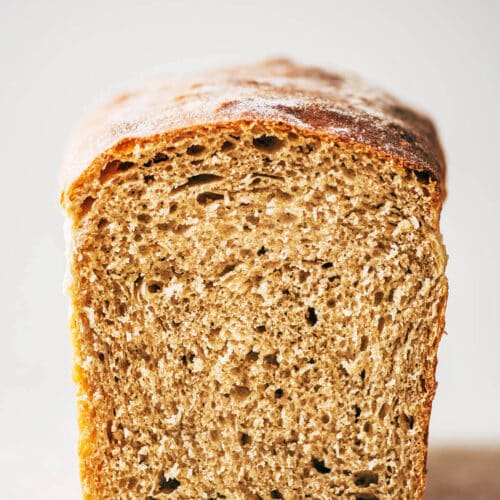

I’m making this now. I’m wondering about leaving it in the refrigerator for two days to develop more flavor. Have you tried that?
Should be fine. Sophie said she hasn't tried it for this specific loaf but we often leave sourdough for 2-3 days before baking so it shouldn't any different here.